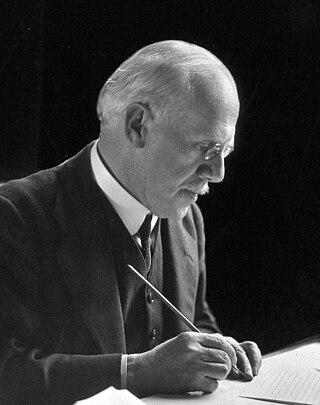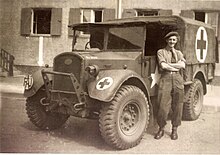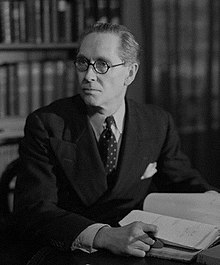
A conscientious objector is an "individual who has claimed the right to refuse to perform military service" on the grounds of freedom of conscience or religion. The term has also been extended to objecting to working for the military–industrial complex due to a crisis of conscience. In some countries, conscientious objectors are assigned to an alternative civilian service as a substitute for conscription or military service.
Robert Calverl(e)y Trevelyan was an English poet and translator, of a traditionalist sort, and a follower of the lapidary style of Logan Pearsall Smith.
Joan Mary Fry was an English Quaker campaigner for peace and social reform.

Sir George Newman was an English public health physician, Quaker, the first Chief Medical Officer to the Ministry of Health in England, and wrote a seminal treatise on the social problems causing infant mortality.
Nora Waln was a best-selling American writer and journalist in the 1930s–50s, writing books and articles on her time spent in Germany and China. She was among the first to report on the spread of Nazism from 1934 to 1938. She traveled widely in Europe and Asia, contributing articles to the Atlantic Monthly and other magazines. She was one of the few correspondents who reported from Communist China and Mongolia, reporting for the Saturday Evening Post for three and a half years, including reporting from the Korean War (1947-1951). She regularly contributed to the Atlantic Monthly from 1925 to 1962.
Michael Hotham Rowntree was a British journalist and social campaigner. He was involved with Oxfam for 60 years, serving as chairman between 1971 and 1977 and Chair Emeritus from 1991.
Mark Plowman, generally known as Max Plowman, was a British writer and pacifist.
Mary Greig Campbell (1907–1989) was a New Zealand librarian, Quaker and relief worker in Shanghai, China, after World War II.
Stephen Henry Hobhouse was an English peace activist, prison reformer, and religious writer.
Christopher Bayldon Barber was a British Quaker businessman and was the Chairman of Oxfam from 1983 to 1989. He was educated at Bootham School, York.
Cecil John Cadoux was a British Christian theologian and writer.
The Non-Combatant Corps (NCC) was a corps of the British Army composed of conscientious objectors as privates, with NCOs and officers seconded from other corps or regiments. Its members fulfilled various non-combatant roles in the army during the First World War, the Second World War and the period of conscription after the Second World War.

Thomas "Corder" Pettifor Catchpool, born Leicester, was an English Quaker and pacifist, actively engaged in relief work in Germany between 1919 and 1952. He was awarded the French Mons Star for his relief work with the Friends Ambulance Unit on the Western Front (1914–1916), subsequently imprisoned in Britain for his absolutist conscientious objection to the Compulsory Military Service Act 1916. After the First World War he was released from prison and critical of the implications of the Treaty of Versailles, played an active role in reconciliation with Germany: in 1919 he assisted with the Friends War Victims Relief Committee in Berlin, an organisation that was involved in organising the feeding of up to one million children per day. Returning to Britain he worked as a welfare coordinator for a Lancashire firm at Darwen, and was responsible for the invitation to Gandhi to visit the mill to witness the impact of the nonviolence campaign on conditions.
The Joint War Organisation (JWO) was a combined operation of the British Red Cross Society and the Order of St John of Jerusalem during the World Wars. It was first created in 1914 and ceased operations when World War I ended in 1919; the organisation was re-formed upon the British entry into World War II in 1939 and was active until its permanent disbanding in 1947. The Joint War Committee (JWC), a non-government administrative body, controlled the JWO and the Joint War Finance Committee managed its finances and concentrated on raising donations and funding.

Elements of the Second Australian Imperial Force (AIF) were located in the United Kingdom (UK) throughout World War II. For most of the war, these comprised only a small number of liaison officers. However, between June and December 1940 around 8,000 Australian soldiers organised into two infantry brigades and supporting units were stationed in the country. Several small engineer units were also sent to the UK, and up to 600 forestry troops were active there between July 1940 and mid-1943. A prisoner of war (POW) repatriation unit arrived in the UK in August 1944, and over 5,600 released AIF prisoners eventually passed through the country. Following the war, small numbers of Australian soldiers formed part of a military cricket team which toured England, and the Army contributed most members of the Australian contingent to the June 1946 victory parade in London.
John Sturge Stephens was born into a prominent family of Quakers in Cornwall. During the First World War, he was a pacifist and conscientious objector and between the wars travelled extensively throughout Europe, on behalf of the Society of Friends, with a view to creating a peaceful future for the continent. In 1938 he helped numerous Austrian Jewish refugees to escape from Nazi persecution, and accommodated several of them at his homes in England.
Fred Haslam was a Canadian administrator and pacifist.
Angela Sinclair-Loutit was an English social justice activist, pacifist and nurse.
The Friends Relief Service (FRS) was a voluntary humanitarian relief organisation formally established by a committee of Britain Yearly Meeting in November 1940. Largely staffed by pacifists and conscientious objectors, its aim was to provide humanitarian relief and social welfare to civilians affected by World War II. Key areas of operation included British cities affected by The Blitz, and refugee camps throughout north-west Europe, the Balkans and the Middle-East. One of its teams was also amongst the first humanitarian groups to reach Bergen-Belsen concentration camp. The organisation had three changes of name: Friends War Victims Relief Committee (November 1940 - February 1942); Friends War Relief Service (February 1942 - September 1943) and the Friends Relief Service (September 1943 - May 1948). The FRS was closed down on May 29, 1948.






